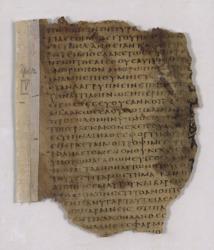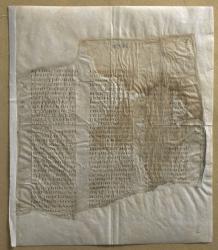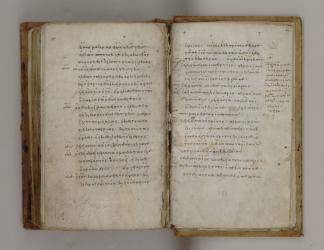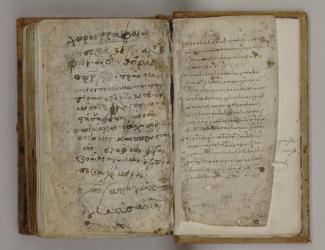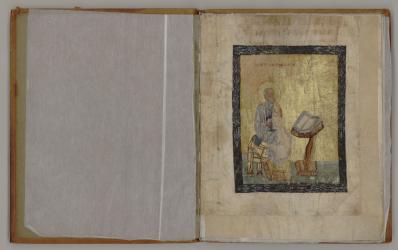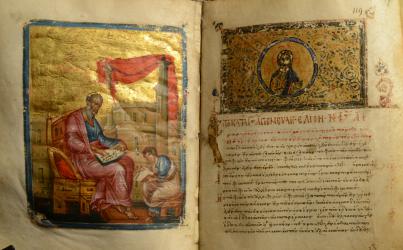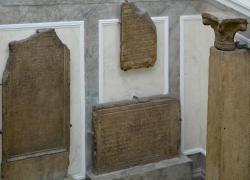Greek Manuscripts
As Late Antiquity was succeeded by the early Christian era, papyrus scrolls gave way to parchment codices. Manuscripts of the early Christian era are written on parchment in uncial letters, the oldest Greek writing style. Among them are fragments of the earliest of the three surviving copies of the ancient Greek Bible known as the Septuagint — the famous Codex Sinaiticus produced in the fourth century. The text in the Codex Sinaiticus is written in four columns per page that was a rare way to arrange it.
Like the Porphyrius Gospel of 835 and the Porphyrius Psalter of 862, these fragments came into the library with the material gathered by Archbishop Porphyrius Uspensky (1804-1855), a palaeographical scholar and passionate collector. This renowned Porphyrius Gospel, created at the Stoudios Monastery in Constantinople, is the oldest surviving Greek manuscript with an exact date of creation, and, at the same time, the first dated manuscript written in minuscule, a new Greek script which replaced uncial letters. No less famous is the Porphyrius Psalter of 862, produced in the Church of the Holy Resurrection in Jerusalem in a special writing style — the Palestinian uncial. Many Greek manuscripts entered the Imperial Public Library by way of the royal palace. In 1858 the Metropolitan of Trebizond in Asia Minor presented Alexander II with a lavishly decorated tenth-century manuscript with 15 magnificent miniatures. Now it is known as the Gospel of Trebizond.13 - 14 cent. (fols. 267, 299) and 17th cent. (fols. 1–11, 91, 128–130, 210, 307, 329, 406). Constantinople, Imperial scriptorium.
Shelfmark: ОР РНБ. Греч. 53
Parchment, purple. Paper (fols. 1–11, 91, 128–130, 210, 307, 329, 406). 410 fols. Minuscule script (text) and small uncial script (comments on the margins). Gold headpieces.
Text is written in gold, marginalia are in silver. Four miniatures were added later: portraits of the Evangelists Matthew, Mark and John — in the 13th – 14th centuries, Luke — in the 17 century.
The original parchment colour is unknown; now it has become dark purple, almost black. The 17th century binding is made of silver with filigree and rhinestones.
'>














Another work from the same source is the Codex Petropolitanus, a sixth-century purple Gospel which Nicholas II bought from the village of Sarmisahly with the assistance of the Russian Archaeological Institute in Constantinople.
Approximately half the library's Greek manuscripts were written in the Byzantine era. They include extremely valuable sources on all aspects of the history and culture of Byzantium, be it book miniatures, palaeography, literature, ecclesiastical music, medicine, astrology, clerical procedures or canon law. The other half of the stocks dates from the time of the fall of the Byzantine Empire and the post-Byzantine period. These still little-studied manuscripts brought to us an interesting layer of late Greek culture, which continues the ancient antique and Christian Byzantine traditions.
Also directly connected with the Ancient World are the stone tablets from the Greek colony of Olbia on the northern Black Sea coast which adorn the library's main staircase. They record the outstanding services which citizens accorded the town and commemorate the erection of statues of gods and emperors. These tablets were donated to the Public Library in 1880 by the widow of Count Alexei Musin-Pushkin in accordance with his will.
View online exhibitions:
Greek Manuscript Gospels of the 6th–13th Centuries
Cultural heritage of Europe in the collections of the National Library of Russia. Cyprus
Cultural heritage of Europe in the collections of the National Library of Russia. Greece
You can also see the full-text study in Russian with illustrations of stone tablets from the Greek colony of Olbia which adorn the library's main staircase.
